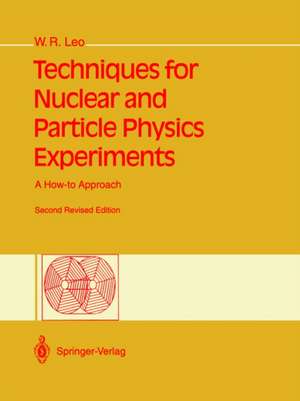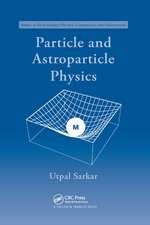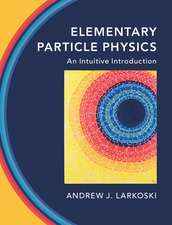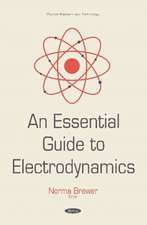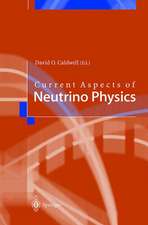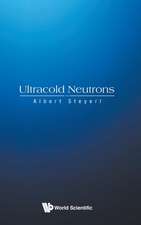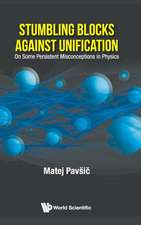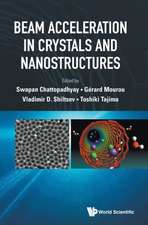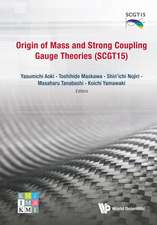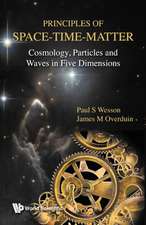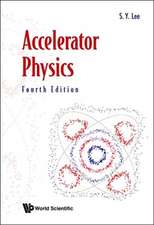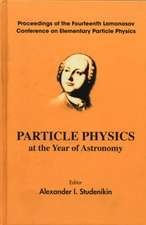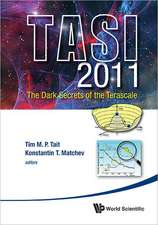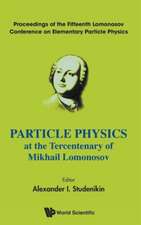Techniques for Nuclear and Particle Physics Experiments: A How-to Approach
Autor William R. Leoen Limba Engleză Paperback – 25 feb 1994
Preț: 960.42 lei
Preț vechi: 1171.25 lei
-18% Nou
Puncte Express: 1441
Preț estimativ în valută:
183.79€ • 190.80$ • 153.26£
183.79€ • 190.80$ • 153.26£
Carte tipărită la comandă
Livrare economică 25 martie-08 aprilie
Preluare comenzi: 021 569.72.76
Specificații
ISBN-13: 9783540572800
ISBN-10: 3540572805
Pagini: 400
Ilustrații: XVIII, 382 p. 12 illus.
Dimensiuni: 210 x 280 x 25 mm
Greutate: 0.88 kg
Ediția:2nd ed. 1994
Editura: Springer Berlin, Heidelberg
Colecția Springer
Locul publicării:Berlin, Heidelberg, Germany
ISBN-10: 3540572805
Pagini: 400
Ilustrații: XVIII, 382 p. 12 illus.
Dimensiuni: 210 x 280 x 25 mm
Greutate: 0.88 kg
Ediția:2nd ed. 1994
Editura: Springer Berlin, Heidelberg
Colecția Springer
Locul publicării:Berlin, Heidelberg, Germany
Public țintă
Professional/practitionerCuprins
1. Basic Nuclear Processes in Radioactive Sources.- 1.1 Nuclear Level Diagrams.- 1.2 Alpha Decay.- 1.3 Beta Decay.- 1.4 Electron Capture (EC).- 1.5 Gamma Emission.- 1.5.1 Isomeric States.- 1.6 Annihilation Radiation.- 1.7 Internal Conversion.- 1.8 Auger Electrons.- 1.9 Neutron Sources.- 1.9.1 Spontaneous Fission.- 1.9.2 Nuclear Reactions.- 1.10 Source Activity Units.- 1.11 The Radioactive Decay Law.- 1.11.1 Fluctuations in Radioactive Decay.- 1.11.2 Radioactive Decay Chains.- 1.11.3 Radioisotope Production by Irradiation.- 2. Passage of Radiation Through Matter.- 2.1 Preliminary Notions and Definitions.- 2.1.1 The Cross Section.- 2.1.2 Interaction Probability in a Distance x. Mean Free Path.- 2.1.3 Surface Density Units.- 2.2 Energy Loss of Heavy Charged Particles by Atomic Collisions.- 2.2.1 Bohr’s Calculation — The Classical Case.- 2.2.2 The Bethe-Bloch Formula.- 2.2.3 Energy Dependence.- 2.2.4 Scaling Laws for dE/dx.- 2.2.5 Mass Stopping Power.- 2.2.6 dE/dx for Mixtures and Compounds.- 2.2.7 Limitations of the Bethe-Bloch Formula and Other Effects.- 2.2.8 Channeling.- 2.2.9 Range.- 2.3 Cherenkov Radiation.- 2.4 Energy Loss of Electrons and Positrons.- 2.4.1 Collision Loss.- 2.4.2 Energy Loss by Radiation: Bremsstrahlung.- 2.4.3 Electron-Electron Bremsstrahlung.- 2.4.4 Critical Energy.- 2.4.5 Radiation Length.- 2.4.6 Range of Electrons.- 2.4.7 The Absorption of ? Electrons.- 2.5 Multiple Coulomb Scattering.- 2.5.1 Multiple Scattering in the Gaussian Approximation.- 2.5.2 Backscattering of Low-Energy Electrons.- 2.6 Energy Straggling: The Energy Loss Distribution.- 2.6.1 Thick Absorbers: The Gaussian Limit.- 2.6.2 Very Thick Absorbers.- 2.6.3 Thin Absorbers: The Landau and Vavilov Theories.- 2.7 The Interaction of Photons.- 2.7.1 Photoelectric Effect.- 2.7.2Compton Scattering.- 2.7.3 Pair Production.- 2.7.4 Electron-Photon Showers.- 2.7.5 The Total Absorption Coefficient and Photon Attenuation.- 2.8 The Interaction of Neutrons.- 2.8.1 Slowing Down of Neutrons. Moderation.- 3. Radiation Protection. Biological Effects of Radiation.- 3.1 Dosimetric Units.- 3.1.1 The Roentgen.- 3.1.2 Absorbed Dose.- 3.1.3 Relative Biological Effectiveness (RBE).- 3.1.4 Equivalent Dose.- 3.1.5 Effective Dose.- 3.2 Typical Doses from Sources in the Environment.- 3.3 Biological Effects.- 3.3.1 High Doses Received in a Short Time.- 3.3.2 Low-Level Doses.- 3.4 Dose Limits.- 3.5 Shielding.- 3.6 Radiation Safety in the Nuclear Physics Laboratory.- 4. Statistics and the Treatment of Experimental Data.- 4.1 Characteristics of Probability Distributions.- 4.1.1 Cumulative Distributions.- 4.1.2 Expectation Values.- 4.1.3 Distribution Moments. The Mean and Variance.- 4.1.4 The Covariance.- 4.2 Some Common Probability Distributions.- 4.2.1 The Binomial Distribution.- 4.2.2 The Poisson Distribution.- 4.2.3 The Gaussian or Normal Distribution.- 4.2.4 The Chi-Square Distribution.- 4.3 Measurement Errors and the Measurement Process.- 4.3.1 Systematic Errors.- 4.3.2 Random Errors.- 4.4 Sampling and Parameter Estimation. The Maximum Likelihood Method.- 4.4.1 Sample Moments.- 4.4.2 The Maximum Likelihood Method.- 4.4.3 Estimator for the Poisson Distribution.- 4.4.4 Estimators for the Gaussian Distribution.- 4.4.5 The Weighted Mean.- 4.5 Examples of Applications.- 4.5.1 Mean and Error from a Series of Measurements.- 4.5.2 Combining Data with Different Errors.- 4.5.3 Determination of Count Rates and Their Errors.- 4.5.4 Null Experiments. Setting Confidence Limits When No Counts Are Observed.- 4.5.5 Distribution of Time Intervals Between Counts.- 4.6 Propagation ofErrors.- 4.6.1 Examples.- 4.7 Curve Fitting.- 4.7.1 The Least Squares Method.- 4.7.2 Linear Fits. The Straight Line.- 4.7.3 Linear Fits When Both Variables Have Errors.- 4.7.4 Nonlinear Fits.- 4.8 Some General Rules for Rounding-off Numbers for Final Presentation.- 5. General Characteristics of Detectors.- 5.1 Sensitivity.- 5.2 Detector Response.- 5.3 Energy Resolution. The Fano Factor.- 5.4 The Response Function.- 5.5 Response Time.- 5.6 Detector Efficiency.- 5.7 Dead Time.- 5.7.1 Measuring Dead Time.- 6. Ionization Detectors.- 6.1 Gaseous Ionization Detectors.- 6.2 Ionization and Transport Phenomena in Gases.- 6.2.1 Ionization Mechanisms.- 6.2.2 Mean Number of Electron-Ion Pairs Created.- 6.2.3 Recombination and Electron Attachment.- 6.3 Transport of Electrons and Ions in Gases.- 6.3.1 Diffusion.- 6.3.2 Drift and Mobility.- 6.4 Avalanche Multiplication.- 6.5 The Cylindrical Proportional Counter.- 6.5.1 Pulse Formation and Shape.- 6.5.2 Choice of Fill Gas.- 6.6 The Multiwire Proportional Chamber (MWPC).- 6.6.1 Basic Operating Principle.- 6.6.2 Construction.- 6.6.3 Chamber Gas.- 6.6.4 Timing Resolution.- 6.6.5 Readout Methods.- 6.6.6 Track Clusters.- 6.6.7 MWPC Efficiency.- 6.7 The Drift Chamber.- 6.7.1 Drift Gases.- 6.7.2 Spatial Resolution.- 6.7.3 Operation in Magnetic Fields.- 6.8 The Time Projection Chamber (TPC).- 6.9 Liquid Ionization Detectors (LID).- 7. Scintillation Detectors.- 7.1 General Characteristics.- 7.2 Organic Scintillators.- 7.2.1 Organic Crystals.- 7.2.2 Organic Liquids.- 7.2.3 Plastics.- 7.3 Inorganic Crystals.- 7.4 Gaseous Scintillators.- 7.5 Glasses.- 7.6 Light Output Response.- 7.6.1 Linearity.- 7.6.2 Temperature Dependence.- 7.6.3 Pulse Shape Discrimination (PSD).- 7.7 Intrinsic Detection Efficiency for Various Radiations.- 7.7.1 Heavy Ions.- 7.7.2 Electrons.- 7.7.3 Gamma Rays.- 7.7.4 Neutrons.- 8. Photomultipliers.- 8.1 Basic Construction and Operation.- 8.2 The Photocathode.- 8.3 The Electron-Optical Input System.- 8.4 The Electron-Multiplier Section.- 8.4.1 Dynode Configurations.- 8.4.2 Multiplier Response: The Single-Electron Spectrum.- 8.5 Operating Parameters.- 8.5.1 Gain and Voltage Supply.- 8.5.2 Voltage Dividers.- 8.5.3 Electrode Current. Linearity.- 8.5.4 Pulse Shape.- 8.6 Time Response and Resolution.- 8.7 Noise.- 8.7.1 Dark Current and Afterpulsing.- 8.7.2 Statistical Noise.- 8.8 Environmental Factors.- 8.8.1 Exposure to Ambient Light.- 8.8.2 Magnetic Fields.- 8.8.3 Temperature Effects.- 8.9 Gain Stability, Count Rate Shift.- 9. Scintillation Detector Mounting and Operation.- 9.1 Light Collection.- 9.1.1 Reflection.- 9.2 Coupling to the PM.- 9.3 Multiple Photomultipliers.- 9.4 Light Guides.- 9.5 Fluorescent Radiation Converters.- 9.6 Mounting a Scintillation Detector: An Example.- 9.7 Scintillation Counter Operation.- 9.7.1 Testing the Counter.- 9.7.2 Adjusting the PM Voltage.- 9.7.3 The Scintillation Counter Plateau.- 9.7.4 Maintaining PM Gain.- 10. Semiconductor Detectors.- 10.1 Basic Semiconductor Properties.- 10.1.1 Energy Band Structure.- 10.1.2 Charge Carriers in Semiconductors.- 10.1.3 Intrinsic Charge Carrier Concentration.- 10.1.4 Mobility.- 10.1.5 Recombination and Trapping.- 10.2 Doped Semiconductors.- 10.2.1 Compensation.- 10.3 The np Semiconductor Junction. Depletion Depth.- 10.3.1 The Depletion Depth.- 10.3.2 Junction Capacitance.- 10.3.3 Reversed Bias Junctions.- 10.4 Detector Characteristics of Semiconductors.- 10.4.1 Average Energy per Electron-Hole Pair.- 10.4.2 Linearity.- 10.4.3 The Fano Factor and Intrinsic Energy Resolution.- 10.4.4 Leakage Current.- 10.4.5 Sensitivity and Intrinsic Efficiency.- 10.4.6 Pulse Shape. Rise Time.- 10.5 Silicon Diode Detectors.- 10.5.1 Diffused Junction Diodes.- 10.5.2 Surface Barrier Detectors (SSB).- 10.5.3 Ion-Implanted Diodes.- 10.5.4 Lithium-Drifted Silicon Diodes — Si(Li).- 10.6 Position-Sensitive Detectors.- 10.6.1 Continuous and Discrete Detectors.- 10.6.2 Micro-Strip Detectors.- 10.6.3 Novel Position-Sensing Detectors.- 10.7 Germanium Detectors.- 10.7.1 Lithium-Drifted Germanium — Ge(Li).- 10.7.2 Intrinsic Germanium.- 10.7.3 Gamma Spectroscopy with Germanium Detectors.- 10.8 Other Semiconductor Materials.- 10.9 Operation of Semiconductor Detectors.- 10.9.1 Bias Voltage.- 10.9.2 Signal Amplification.- 10.9.3 Temperature Effects.- 10.9.4 Radiation Damage.- 10.9.5 Plasma Effects.- 11. Pulse Signals in Nuclear Electronics.- 11.1 Pulse Signal Terminology.- 11.2 Analog and Digital Signals.- 11.3 Fast and Slow Signals.- 11.4 The Frequency Domain. Bandwidth.- 12. The NIM Standard.- 12.1 Modules.- 12.2 Power Bins.- 12.3 NIM Logic Signals.- 12.4 TTL and ECL Logic Signals.- 12.5 Analog Signals.- 13. Signal Transmission.- 13.1 Coaxial Cables.- 13.1.1 Line Constituents.- 13.2 The General Wave Equation for a Coaxial Line.- 13.3 The Ideal Lossless Cable.- 13.3.1 Characteristic Impedance.- 13.4 Reflections.- 13.5 Cable Termination. Impedance Matching.- 13.6 Losses in Coaxial Cables. Pulse Distortion.- 13.6.1 Cable Response. Pulse Distortion.- 14. Electronics for Pulse Signal Processing.- 14.1 Preamplifiers.- 14.1.1 Resistive vs Optical Feedback.- 14.2 Main Amplifiers.- 14.3 Pulse Shaping Networks in Amplifiers.- 14.3.1 CR-RC Pulse Shaping.- 14.3.2 Pole-Zero Cancellation and Baseline Restoration.- 14.3.3 Double Differentiation or CR-RC-CR Shaping.- 14.3.4 Semi-Gaussian Shaping.- 14.3.5 Delay Line Shaping.- 14.4Biased Amplifiers.- 14.5 Pulse Stretchers.- 14.6 Linear Transmission Gate.- 14.7 Fan-out and Fan-in.- 14.8 Delay Lines.- 14.9 Discriminators.- 14.9.1 Shapers.- 14.10 Single-Channel Analyzer (Differential Discriminator).- 14.11 Analog-to-Digital Converters (ADC or A/D).- 14.11.1 ADC Linearity.- 14.12 Multichannel Analyzers.- 14.13 Digital-to-Analog Converters (DAC or D/A).- 14.14 Time to Amplitude Converters (TAC or TPHC).- 14.15 Scalers.- 14.16 Ratemeter.- 14.17 Coincidence Units.- 14.18 Majority Logic Units.- 14.19 Flip-Flops.- 14.20 Registers (Latches).- 14.21 Gate and Delay Generators.- 14.22 Some Simple and Handy Circuits for Pulse Manipulation.- 14.22.1 Attenuators.- 14.22.2 Pulse Splitting.- 14.22.3 Pulse Inversion.- 14.23 Filtering and Shaping.- 14.23.1 Pulse Clipping.- 14.23.2 High-Pass Filter or CR Differentiating Circuit.- 14.23.3 RC Low-Pass Filter or Integrating Circuit.- 15. Pulse Height Selection and Coincidence Technique.- 15.1 A Simple Counting System.- 15.2 Pulse Height Selection.- 15.2.1 SCA Calibration and Energy Spectrum Measurement.- 15.2.2 A Note on Calibration Sources.- 15.3 Pulse Height Spectroscopy with Multichannel Analyzers.- 15.4 Basic Coincidence Technique.- 15.4.1 Adjusting the Delays. The Coincidence Curve.- 15.4.2 Adjusting Delays with the Oscilloscope.- 15.4.3 Accidental Coincidences.- 15.5 Combining Pulse Height Selection and Coincidence Determination. The Fast-Slow Circuit.- 15.6 Pulse Shape Discrimination.- 16. Electronic Logic for Experiments.- 16.1 Basic Logic Gates: Symbols.- 16.2 Boolean Laws and Identities.- 16.3 The Inhibit or Busy.- 16.4 Triggers.- 16.4.1 One-Body Scattering.- 16.4.2 Two-Body Scattering.- 16.4.3 Measurement of the Muon Lifetime.- 17. Timing Methods and Systems.- 17.1 Walk and Jitter.- 17.2 Time-Pickoff Methods.- 17.2.1 Leading Edge Triggering (LE).- 17.2.2 Fast Zero-Crossing Triggering.- 17.2.3 Constant Fraction Triggering (CFT).- 17.2.4 Amplitude and Risetime Compensated Triggering (ARC).- 17.3 Analog Timing Methods.- 17.3.1 The START-STOP Time-to-Amplitude Converter.- 17.3.2 Time Overlap TAC’s.- 17.4 Digital Timing Methods.- 17.4.1 The Time-to-Digital Converter (TDC).- 17.4.2 The Vernier TDC.- 17.4.3 Calibrating the Timing System.- 18. Computer Controlled Electronics: CAMAC.- 18.1 CAMAC Systems.- 18.2 The CAMAC Standard.- 18.2.1 Mechanical Standards.- 18.2.2 Electrical Standards: Digital Signals.- 18.3 The CAMAC Dataway.- 18.3.1 Common Control Signals (Z,C,I).- 18.3.2 Status Signals.- 18.3.3 Timing Signals.- 18.3.4 Data Signals.- 18.3.5 Address Signals.- 18.3.6 Command Signals.- 18.3.7 Pin Allocations.- 18.4 Dataway Operations.- 18.4.1 Dataway Timing.- 18.4.2 Block Transfers.- 18.5 Multi-Crate Systems — The Branch Highway.- 18.6 CAMAC Software.- A. A Review of Oscilloscope Functions.- A. 1 Basic Structure.- A.1.1 Bandwidth and Risetime.- A.2 Controls and Operating Modes.- A.2.1 Input Coupling.- A.2.2 Vertical and Horizontal Sensitivity.- A.2.3 Triggering (Synchronization).- A.2.4 Display Modes.- A.3 Applications and Examples.- A.3.1 Signal Viewing.- A.3.2 Comparison of Signals.- B. Physical and Numerical Constants.- C. Resistor Color Code.- References.
